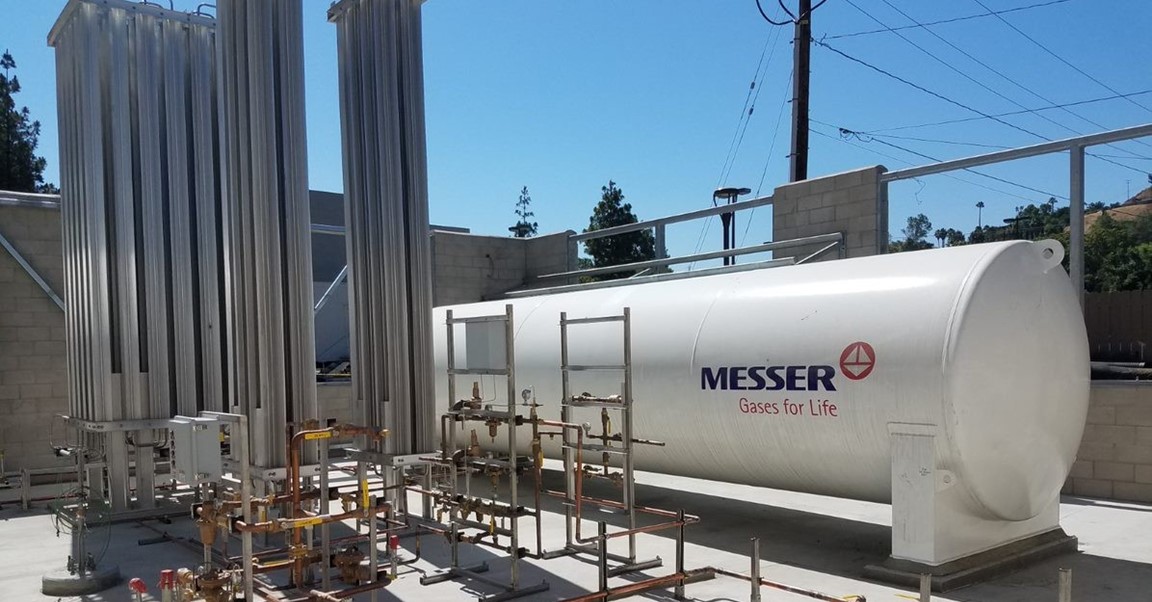In 2015, Loma Linda University Medical Center (LLUMC) in Loma Linda, California decided to undergo a major hospital expansion. The project scope included a new bulk medical oxygen supply station. Because LLUMC sits on seismic fault lines, the oxygen supply station needed to be specially designed and constructed. Complexities with regulatory approvals and design challenges necessitated precise project management. LLUMC partnered with Messer to design, build, and provide a turnkey project, which included the relevant design, installation, and project management services.
Messer completed the custom high-seismic installation on budget and in time for the opening of LLUMC’s expansion, resulting in a satisfied customer.
Background
LLUMC has been ranked among the top hospitals in its metro area for 2019-20 by U.S. News & World Report. The 714-bed LLUMC treats more than 16,000 inpatients and receives about 470,000 outpatient visits a year. Loma Linda University Health has embarked on a Campus Transformation Project, which includes the new LLUMC tower and the adjacent Loma Linda University Children’s Hospital Tower.
The approximately 1 million square-foot addition entails 320 new single-patient rooms plus new neurosurgical, trauma, and transplant surgical suites and services.
At 268 feet high, the new towers are fixed on 126 seismic base isolators designed to withstand a major earthquake. After determining that the existing bulk medical oxygen (O2) equipment was inadequate, Messer installed a new, larger oxygen storage station with these seismic considerations in mind.
Campus transformation
Rockton Hill, LLUMC’s project manager, said the Campus Transformation Project construction timeline dictated the schedule for the bulk O2 station installation.
“We had to have a new bulk oxygen system up and running by the time the contractors working on the Campus Transformation Project team needed O2 for testing and commissioning followed by Office of Statewide Health Planning and Development (OSHPD) occupancy,” said Hill. “It resulted in a three- to four-year-long project, with multiple levels of activity, governed by a joint permitting process. Obtaining local, state, and OSHPD permits take a couple of years of planning, design, and receiving plan approval.”
Find out how to develop a bulk medical oxygen strategy in our guide.
Bulk medical oxygen specifications
Hill knew Messer as a leading provider of bulk medical gas supply systems and services.
“Based on our O2 supply requirement, Messer established a basis of design requirements for new medical bulk installation,” says Hill. “Messer determined the necessary equipment and sizing.” Based on LLUMC’s specified needs and the proximity from Messer’s oxygen plant, Messer specified a main tank, reserve tank, and the required vaporization to provide O2 to the Campus Transformation Project, a faculty medical office, and a future hyperbaric O2 therapy suite. The team designed the system for a high flow (more than twice their average consumption) to accommodate possible future expansion.
Messer recommended, and LLUMC agreed, to increase the size of the O2 reserve above mandated levels to increase the security of supply. “In California, due to seismic concerns, it is sensible for a hospital to be able to function for three days without outside assistance such as O2 deliveries,” says Mark DiMaggio, Vice President of Applications, Marketing & Execution at Messer Americas. “By having reserve capacity of three days vs. one day required by code, it helps ensure the hospital has reserve capacity to tide it through an earthquake or other unforeseen event.”
Seismic bracing
LLUMC sits on seismic faults, so the design had to be ready to withstand a major earthquake of 7.0 magnitude. “It was a learning curve for everyone, and it was certainly challenging,” said Hill. “But Messer acquired the necessary resources to calculate and derive the information we needed to obtain a building permit,” said Hill.
Messer routinely faces permitting and design challenges, but the additional severe seismic requirements made the project more complex than a typical bulk equipment installation. For instance, standard bulk equipment is rated for 200 percent spectral response acceleration (Ss) which accommodates the vast majority of geographies in the United States, but LLUMC’s location requires 244 percent Ss. Therefore, Messer needed to produce site-specific documents and drawings for LLUMC to move the project through OSHPD permitting, including the earthquake-proof specifications for the tank and its supports.
Installation of bulk oxygen system
In June 2020, both bulk oxygen tanks were safely lowered into place on braced saddles specially designed and constructed for them. The tanks were first filled in January 2021. LLUMC is using the bulk oxygen now to test the medical gas outlets in the new tower ahead of a tentative opening in late spring 2021.
Of course, no facet of business escaped considerations related to COVID-19 and this project was no exception. While no design or capacity requirement changes were needed to cope with the pandemic, safety protocols were established for on-site work. The construction crews followed all CDC safety guidelines regarding masks, sanitizing stations, social distancing, and other measures.
Learn more about the process of building a bulk medical oxygen system, from plant to patient.
“Working with Messer was a great experience,” says Hill. “I am proud and thankful to be part of this team and to produce something of this nature for our hospital.”

